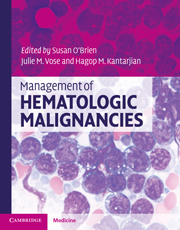Book contents
- Frontmatter
- Contents
- List of contributors
- 1 Molecular pathology of leukemia
- 2 Management of acute myeloid leukemia
- 3 Treatment of acute lymphoblastic leukemia (ALL) in adults
- 4 Chronic myeloid leukemia
- 5 Chronic lymphocytic leukemia/small lymphocytic lymphoma
- 6 Myelodysplastic syndromes (MDS)
- 7 Hairy cell leukemia
- 8 Acute promyelocytic leukemia: pathophysiology and clinical results update
- 9 Myeloproliferative neoplasms
- 10 Monoclonal gammopathy of undetermined significance, smoldering multiple myeloma, and multiple myeloma
- 11 Amyloidosis and other rare plasma cell dyscrasias
- 12 Waldenstrom's macroglobulinemia/lymphoplasmacytic lymphoma
- 13 WHO classification of lymphomas
- 14 Molecular pathology of lymphoma
- 15 International staging and response criteria for lymphomas
- 16 Treatment approach to diffuse large B-cell lymphomas
- 17 Mantle cell lymphoma
- 18 Follicular lymphomas
- 19 Hodgkin lymphoma: epidemiology, diagnosis, and treatment
- 20 Treatment approaches to MALT/marginal zone lymphoma
- 21 Peripheral T-cell lymphomas
- 22 Mycosis fungoides and Sézary syndrome
- 23 Central nervous system lymphoma
- 24 HIV-related lymphomas
- 25 Lymphoblastic lymphoma
- 26 Burkitt lymphoma
- Index
- References
16 - Treatment approach to diffuse large B-cell lymphomas
Published online by Cambridge University Press: 10 January 2011
- Frontmatter
- Contents
- List of contributors
- 1 Molecular pathology of leukemia
- 2 Management of acute myeloid leukemia
- 3 Treatment of acute lymphoblastic leukemia (ALL) in adults
- 4 Chronic myeloid leukemia
- 5 Chronic lymphocytic leukemia/small lymphocytic lymphoma
- 6 Myelodysplastic syndromes (MDS)
- 7 Hairy cell leukemia
- 8 Acute promyelocytic leukemia: pathophysiology and clinical results update
- 9 Myeloproliferative neoplasms
- 10 Monoclonal gammopathy of undetermined significance, smoldering multiple myeloma, and multiple myeloma
- 11 Amyloidosis and other rare plasma cell dyscrasias
- 12 Waldenstrom's macroglobulinemia/lymphoplasmacytic lymphoma
- 13 WHO classification of lymphomas
- 14 Molecular pathology of lymphoma
- 15 International staging and response criteria for lymphomas
- 16 Treatment approach to diffuse large B-cell lymphomas
- 17 Mantle cell lymphoma
- 18 Follicular lymphomas
- 19 Hodgkin lymphoma: epidemiology, diagnosis, and treatment
- 20 Treatment approaches to MALT/marginal zone lymphoma
- 21 Peripheral T-cell lymphomas
- 22 Mycosis fungoides and Sézary syndrome
- 23 Central nervous system lymphoma
- 24 HIV-related lymphomas
- 25 Lymphoblastic lymphoma
- 26 Burkitt lymphoma
- Index
- References
Summary
Introduction
Non-Hodgkin lymphoma (NHL) is a heterogeneous cancer encompassing several dozen distinct clinicopathologic diseases. The incidence of NHL appears to be rising independent of the aging of the population, and NHL currently ranks as the fifth most common cancer in both men and women with 71,380 new cases in 2007 and nearly 20,000 estimated deaths. Diffuse large B-cell lymphoma (DLBCL), accounting for approximately one-third of all new cases, is both the most common histologic subtype of NHL and the prototype of aggressive lymphomas.
There are several histologic variants and clinical subtypes of DLBCL that are recognized (Figure 16.1). Histologic variants include immunoblastic, centroblastic, and anaplastic morphologies, whereas distinct clinical subtypes have included primary mediastinal large B-cell lymphoma (PMBL), intravascular large B-cell lymphoma, and primary effusion lymphoma, among others. The latter two entities occur primarily in immunocompromised hosts and are associated with human herpesvirus 8. The histologic heterogeneity of DLBCL is complicated by the recent identification of molecular heterogeneity discovered by gene expression profiling, and is discussed in more detail below with an emphasis on its prognostic potential.
In general, DLBCL is a chemosensitive disease with a substantial portion of patients achieving cure with frontline chemoimmunotherapy. Unfortunately, many patients continue to relapse and are in need of further treatment. Patients with chemosensitive disease at relapse can achieve long-term disease control with autologous stem cell transplant, but others will succumb to DLBCL. Patients with refractory disease, those who relapse following transplant, and those who are not candidates for transplantation have no true curative options and most will ultimately die of lymphoma.
- Type
- Chapter
- Information
- Management of Hematologic Malignancies , pp. 286 - 307Publisher: Cambridge University PressPrint publication year: 2010



